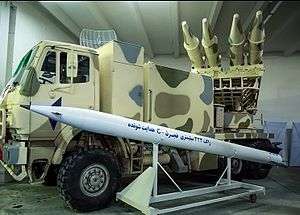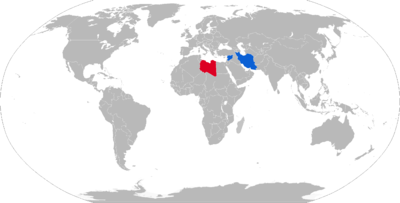Fajr-5
| Fajr-5 | |
|---|---|
 Fajr-5C GPS guided surface-to-surface missile | |
| Type | Rocket artillery |
| Place of origin | Iran |
| Service history | |
| Used by | See Operators |
| Wars |
2006 Lebanon War Gaza–Israel conflict Syrian Civil War |
| Production history | |
| Designer | ? |
| Designed | ? |
| Manufacturer | ? |
| Specifications | |
| Weight |
1,500 kg (System) 90 kg (HE Content) 175 kg (Warhead) 915 kg (Rocket)[1] |
| Length |
10.45 m (Launcher) 6.485 m (Rocket)[1] |
| Width | 2.54 m (Launcher)[1] |
| Height | 3.34 m (Launcher)[1] |
|
| |
| Caliber | 333 mm |
| Elevation | 0 to 57 degrees[1] |
| Traverse | 45 degrees left and right[1] |
| Rate of fire | 4–8 seconds[1] |
| Effective firing range | 68–75 km |
|
| |
| Speed | 1009 m/s |
The Fajr-5 (Persian: فجر-۵, "Dawn") is an Iranian 333 mm artillery rocket MLRS developed in the 1990s with a range of 75 kilometers (50 mi).[2] Most Fajr-5 rockets are unguided; in 2017 Iran introduced a variant, the Fajr-5C, which adds GPS guidance.
Design
MLRS
The latest production of the Fajr-5 is installed on a new 6×6 forward control chassis[3] and the platform is now integrated into a complete weapon system rather than an individual launcher. To provide a more stable firing platform four hydraulically operated stabilizers are lowered to the ground before firing. The new chassis has improved cross-country mobility and the forward control fully enclosed cab provides space for the driver and two passengers. Another fully enclosed cabin to the immediate rear of the cab houses the remainder of the crew.
In May 2006, Iran's Aerospace Industries Organization developed an upgraded version of the Fajr-5 with an improved chassis. AIO says that a radar can be added to give the system the capability to track and engage naval targets.[4]
The primary role of this artillery rocket system is the engagement of land targets. The Fajr-5 is normally fired from a truck launcher, but it can be fired individually.[5]
Fajr-5 MRLS can be networked together.[6]
Rocket
Iran produces a two-stage Fajr-5 with a length of 9 m and range of 190 km. This variant is launched from TELs similar to Zelzal rockets, which only have the capacity for a single rocket.
Fajr-5 rockets can likely carry submunitions or chemical weapons.[7]
In February 2017, Iran revealed a guided version of the Fajr-5, similar to the Chinese SY300. It has a firing accuracy of 250 m when using INS and 50 m using GNSS, with range from 40–130 km (25–81 mi).[8]
History
The first Fajr-5 were created when China exported WS-1 MLRS to Iran in the late 1980s/early 1990s.[9] They were then subsequently created and produced by Iran's Aerospace Industries Organization.
Operational history
Iran supplied a number of Fajr-5s to Hezbollah in Lebanon beginning in 2002.[10][11] Sources disagree on whether Hezbollah used Fajr-5 rockets in the 2006 Lebanon War,[12] in part because at the time they were confused with similar Khaibar-1 rockets.
In November 2012 during Operation Pillar of Defense, Hamas and Palestinian Islamic Jihad fired Fajr-5 rockets towards Tel Aviv and Jerusalem. One hit an apartment block in Rishon LeZion. The commander of the Iranian Guard said that Iran did not supply Gaza with a Fajr-5 missile but transferred the technology to manufacture it to the Palestinians.[13]
On May 10th 2018, the IRGC's Quds Force fired 20 rockets into the Israeli-occupied Golan Heights from Syrian territory. Some of these were Fajr-5s.[14]
Operators

Current operators
References
- 1 2 3 4 5 6 7 Fajr-3 & Fajr-5 brochure. Retrieved on May 13, 2008.
- ↑ UPI (Nov 3, 2009). "'Gaza rockets can now hit Tel Aviv'". www.spacewar.com.
- ↑ "Fadjr-5". Archived from the original on 2008-05-10.
- ↑ Foss, Christopher F (8 May 2006). "Fadjr-5 artillery rocket system gets new chassis". Jane's Information Group. Archived from the original on 14 June 2006. Retrieved 2006-07-30.
- ↑ Anthony H. Cordesman, Martin Kleiber. Iran's Military Forces and Warfighting Capabilities (2007) ISBN 978-0-89206-501-1 p.60-61
- ↑ Wright, Author: Galen (20 May 2011). "The Arkenstone - ارکنستون: Fajr Rocket (MLRS) Artillery".
- ↑ Wright, Author: Galen (20 May 2011). "The Arkenstone - ارکنستون: Fajr Rocket (MLRS) Artillery".
- ↑ Administrator. "Iran unveils new Fajr 5 300mm MLRS Multiple Launch Rocket System using guided rockets 10702171 - February 2017 Global Defense Security army news industry - Defense Security global news industry army 2017 - Archive News year". armyrecognition.com.
- ↑ "Vital Perspective". Vital Perspective.
- ↑ Devenny, Patrick (1 January 2006). "Hezbollah's Strategic Threat to Israel". Middle East Quarterly.
- ↑ Gordon, Michael (September 27, 2002) "Militants Are Said to Amass Missiles in South Lebanon," The New York Times.
- ↑ Lambeth, B. S. (2011). Air operations in Israel's war against Hezbollah: Learning from Lebanon and getting it right in Gaza. Santa Monica, CA, United States: RAND. ISBN 978-0-8330-5146-2
- ↑ "Iran transferred Fajr-5 missile technology to Gaza: IRGC chief". 21 November 2012. Archived from the original on 27 November 2012.
- ↑ Spyer, Jonathan. "Israel's Secret War Against Iran Is Widening".
- ↑ Black, Ian (16 November 2012). "Fajr-5 missile gives Palestinians rare if short-lived advantage". the Guardian.
- ↑ http://articles.janes.com/articles/Janes-Missiles-And-Rockets-2004/Iran-supplies-improved-rockets-to-Syria-and-Hizbullah.html%5Bpermanent+dead+link%5D